The Best Solar-Powered Generators for Both Off-Grid Adventures and Power Outage Emergencies

"Hearst Magazines and Yahoo may earn commission or revenue on some items through these links."
These days, gas-powered generators aren’t the only option for charging on the go. Solar-powered generators—also called portable power stations—are a growing sector of the power market. I started using these a few years ago and was thrilled with having a clean, efficient charging system that doesn't roar or burn through gas.
I spend summer and winter on minimalist backcountry trips, but my shoulder seasons are spent base-camping in warmer climates with my truck camping system, and I often work remotely from the road. Car camping, overlanding, glamping, and van-based remote work have grown over the past several years, and with that has brought innovations in gear versatility. This often means battery-powered items, whether it’s a smartphone, computer, rechargeable lights, or even a powered cooler or fridge.
Larger units can also provide peace of mind in areas where power outages are a concern. Depending on output, many of these portable power stations can sustain household appliances the way a gas generator would. Run out of juice? Attach a few solar panels and you’ll start recharging the power station immediately— no emergency fuel run necessary.
While plenty of people I know use these to power home appliances, my own use is mainly focused on smaller units. I keep a Goal Zero Yeti 200X in my car camping bin, and have used Jackery’s fast-charging Explorer 240 as a backup when power might be unreliable. I’m usually looking to keep my phone, headlamp, and headphones charged, but I’ve used power banks to heat water in an electric kettle, grind coffee, and power my laptop during remote work sessions.
My primary concerns are portability and convenience, which means I appreciate fast wall and solar charging, and since I always like to have a backup, I seek out units that don’t drain power in storage. Ease of use is also important—is the display easy to read? Does it make sense on the screen? Bonus points if I can tell how much power is available via a quick glance. In the past few years, these criteria have become easier to meet. There are now plenty of compact, affordable units that have better charging capabilities than before. Think of these as giant versions of battery power banks used to charge phones during travel or when outlets are scarce.
Most power stations can be charged in a wall outlet, a vehicle's 12-volt port, or with solar panels (often sold separately). Once the charging station is juiced up, you can charge battery-powered gadgets on the go, or keep lights or appliances running off-grid with the bigger, higher-powered models. Each unit holds a certain capacity for charging devices, measured in watt hours, or Wh.
In the future, I’d love to see the weight-to-power ratio continue to progress, with lighter, more portable units that don’t skimp on charging capabilities. I’m also somewhat surprised that we don’t see more advanced screen options on most units, with most currently only offering a fairly basic LCD readout. It gets the job done, but some of the readouts and stats can be confusing to toggle through.
For these picks, I took into consideration my own testing and consulting, charging capacity, ease of use, weight, and what different people might need them for. In the most recent update, Popular Mechanics test editor Brad Ford was instrumental in providing additional input for larger-capacity usage cases.
Finally, “solar-powered” doesn’t mean you need the sun to charge these power stations. They all have the capability to charge with solar panels, but almost all of them can charge in an AC wall outlet or with a 12-volt vehicle port.
The Best Solar-Powered Generators
Best Overall: Jackery Explorer 1000 Portable Power Station
Largest Capacity: Bluetti AC200MAX Expandable Power Station
Best Portable Option: Goal Zero Yeti 200X Solar Generator
Best Budget-Friendly Option: Jackery Explorer 240 Portable Power Station
Most Versatile: Goal Zero Yeti 1500X Solar Generator
The Expert: I have been traveling in the outdoors for as long as I can remember, and I’ve spent the past decade reviewing camping gear, overlanding items, and other outdoor equipment. I take multiple extended car-camping trips each year with a portable, convenient setup that includes barely more than a bin of car-camping goods, a piece of memory foam, and the topper on my truck.Since I’m usually working while I’m on the road, my main charging needs are personal devices like a phone, laptop, and headlamp. My go-to portable power solutions are typically mid-range in size and capacity, as I don’t need a ton of charging on the road like someone powering the lights in a trailer or RV would need.
My go-to portable power solutions are typically mid-range in size and capacity, as I don’t need a ton of charging on the road like someone powering the lights in a trailer or RV would need. For this update, I consulted with the Popular Mechanics in-house test team, with input from test editor Brad Ford for larger devices and at-home usage.
What to Consider
What is a solar generator?
In some ways, solar generators are misnamed. “Technically, a PV (photovoltaic) panel—or solar panel—is what generates power,” says Ford. “The problem is that sunlight varies throughout the day, so voltage fluctuates and there is no sunlight available at night.” This means that a battery is technically needed to store power, and a power inverter is needed to convert and provide constant alternating current (AC) used for most electrical devices.
The battery and inverter combine in one unit and become a power station. Solar panels without a power station are not particularly useful, so the term “solar generator” typically refers to both the panels and the station used in conjunction.
What Size and How Much Capacity Do You Need?
One of the main differences in these models is how much charging “juice” they can store, referenced in watt-hours. Watt-hours are a measure of a unit of energy (watts) that can flow over time (hours). Consider the electronics you plan to pack or will need to keep charged, and how much juice you’ll need for each one. This can also pertain to estimating generator size for potential home back-up.
For instance, running a refrigerator will take a lot more power than recharging your phone or powering your lights. Consider making a list of the items you’ll need to charge or power, and checking how much each one needs to run. From there, consider how much time you’ll need to run them, and how long the solar-powered generator will take to recharge once it is depleted.
Note that solar panel specs list the highest capacity the panel is capable of, in the perfect conditions—it is not uncommon to see only 50% to 75% of the watts a panel is listed for.
Charging Capacity
This goes hand in hand with your needs. Once you figure out what you’ll be charging or running with your power station, you can start comparing capacities per full charge or hour of use on each unit. The price goes up as the capacity increases, but most people heading out for an off-grid weekend will want at least around 40 amp-hours, or 500 watt-hours.
If you’re looking for a home-powering backup for power outages, look for a model with at least 3,000Wh, and I recommend 500 watts (minimum) of solar panels for recharging. Keep in mind that solar panels are not usually included with the unit, and I recommend buying both at the same time for maximum efficiency in charging.
I listed the watt hours as “Wh” in the specs for each model for easier comparison.
Portability
While weight and size don’t directly correlate to the technicalities of power banks, they impact the convenience of each model. Many camping and overlanding setups have limited space, so the more compact models likely have a higher appeal as a result.
That said, most units weigh at least 10 pounds, and the weight and size increase quickly with greater capacities. Before purchasing, consider where you plan to store the power bank, and the space in your vehicle or camper where it will live while you’re on the road. If you plan to use this power bank solely as a home backup option, portability will matter less, but consider how much effort it will take to move it around within your home or in your outdoor space.
How We Selected
I’m a seasonal car camper. This means I take off for base-camping trips in spring and fall when the deep wilderness is hard to access here in Montana. I’ve spent the last few seasons testing a variety of solar-powered generators to power my smaller items, like phones, headphones, small battery packs, speakers, headlamps, and sometimes my laptop. Since my car camping setup is low-tech (no portable fridge to be found), I’ve rarely needed anything bigger than 300 Wh, or the equivalent of about 25 phone charges. I have tested larger models for the express purpose of gear trials, however.
My testing ranged from a quick overnight to more than a week on the road, and included charging power banks in AC outlets, in the 12V outlet in my truck on road trips, and with solar panels. I compared charging capacity, weight, power input, and how easy each unit is to use and transport. For the ones I didn’t personally test, I talked to overlanding experts and car campers, looking for a range of models that will suit everyone from users with less charging needs (like myself) to people looking for a backup for household appliances and to power their camper appliances.
It’s all about compromise, which means balancing charging capacity with weight and price. The heavier models with lower charging capacities and longer recharge times didn’t make the cut, and I did my best to balance the criteria for a variety of models that suit different needs. Price typically doesn’t factor into my picks, though I did list a few smaller, more affordable models.
Explorer 1000 Portable Power Station
This is a fan favorite for car campers, remote workers, and overlanders. I used it on a media trip where we had to keep multiple camera batteries charged during a week-long outing. It has a max capacity of 1,002 watt-hours, which is lower than you'll find with others on this list, but can actually power items for longer than some higher-capacity models. This won’t be your best bet for powering larger appliances, but it’s an ideal power station for smaller items and off-grid camping.
We charged our photographer’s camera batteries while we were charging the power bank on solar power (it was a very sunny winter day), which proved effective and efficient.
This model has eight ports, including two AC outlets, two USB-C ports, a 12-volt car port, and two standard USB-A outlets. It can charge a typical laptop eight times or power a small refrigerator or powered cooler for over 15 hours.
The Jackery Explorer 1000 can be charged with solar panels or a 12-volt outlet in your vehicle while you’re on the move, and we did both on our trip. It has fairly standard charging times, with 11.5 hours in a car outlet, 6.5 hours for solar panels, and just 5.5 hours to fully charge in a wall outlet. I did find this somewhat hard to use after dark, and had to use my phone flashlight to see the sides of the power bank that didn’t have lights. Otherwise, very few complaints.
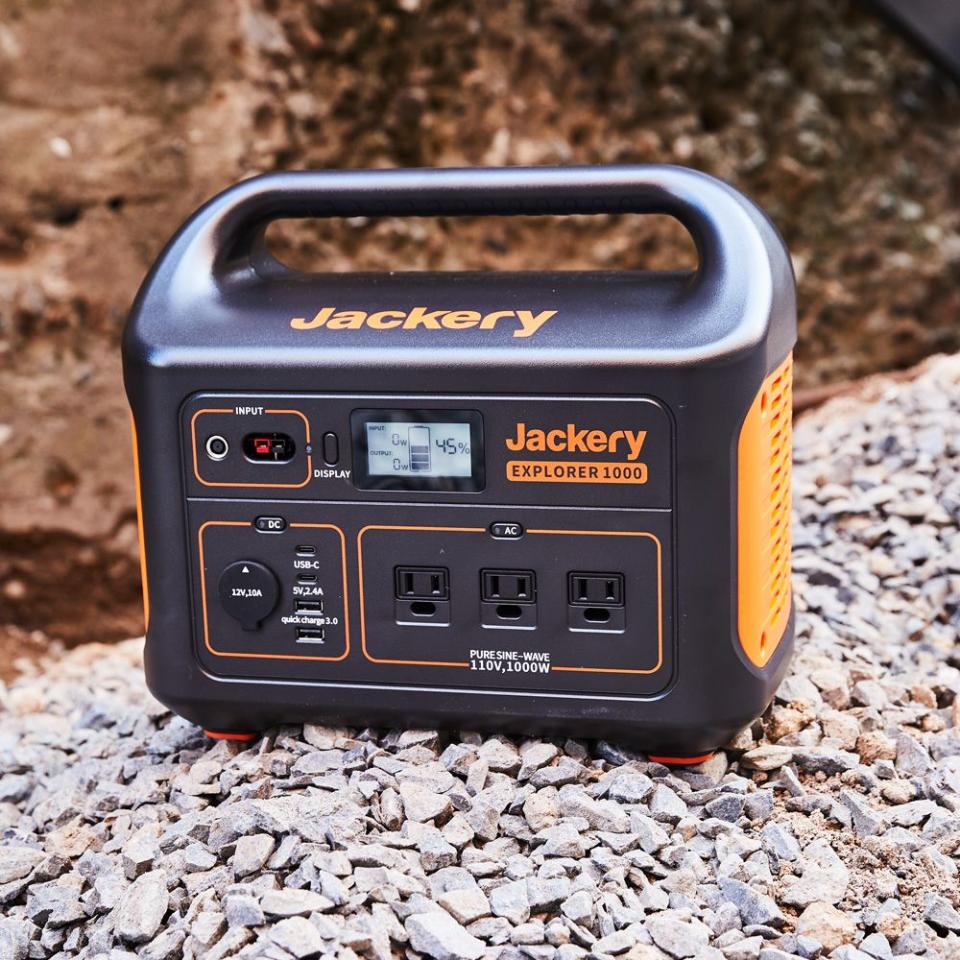
Explorer 1000 Portable Power Station
amazon.com
$639.99
Trevor RaabAC200MAX Expandable Power Station
For home backup, Bluetti’s AC200MAX is a powerful solar generator that allows you to stay off-grid while keeping appliances running. The 2,048 watt-hours battery capacity and 2,200-watt power output can handle everything from a refrigerator to keeping travel trailer lights on. One of the key features is the expandable capacity—increasing the capacity to more than 8,000 total watt-hours—by connecting the power station to additional batteries. The batteries are sold separately, but for people concerned about keeping appliances running in the event of a power outage, it’s worth the extra expense for peace of mind.
Charge time in an AC outlet can take up to six hours, but dual charging capabilities mean in the right conditions, you can have this unit fully charged in two hours by using a solar panel in conjunction with grid charging—increasing input from 900 Wh to 1400 Wh. The station has 16 charging ports, including wireless charging pads, AC, USB-A, USB-C, and 12-volt ports for both car and RV charging.
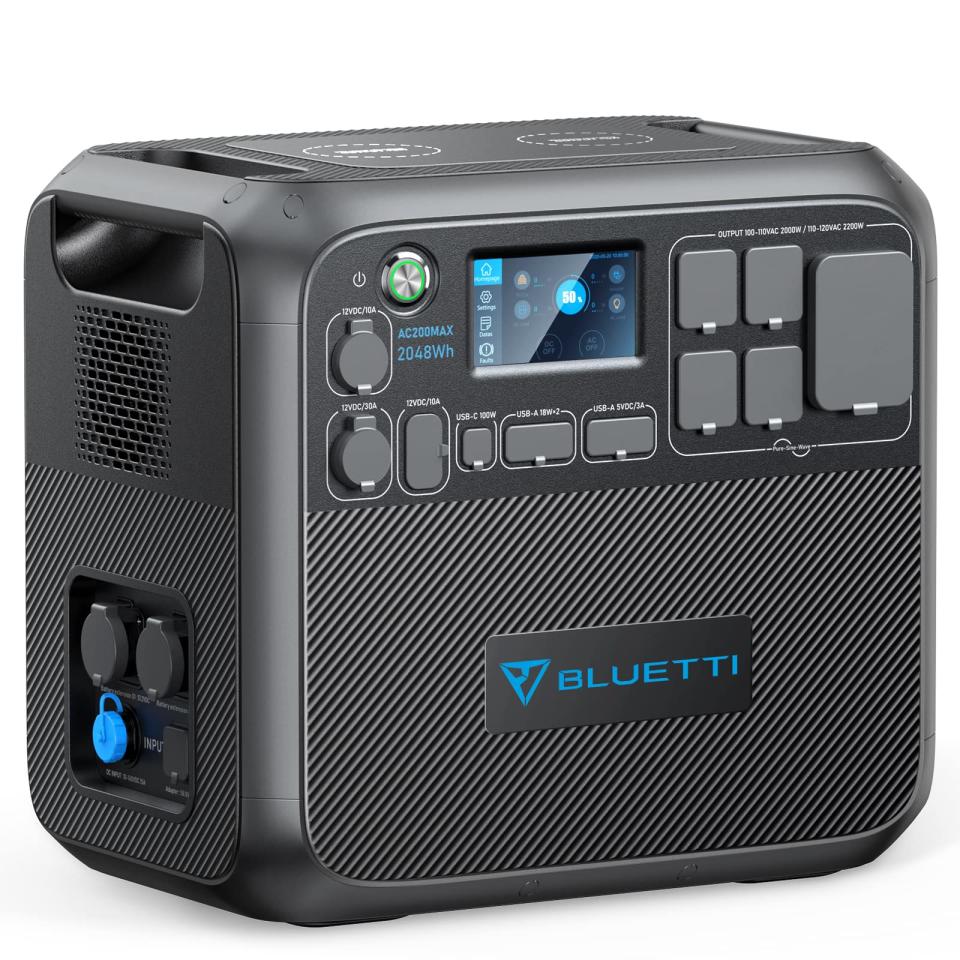
AC200MAX Expandable Power Station
amazon.com
$1249.00
Yeti 200X Solar Generator
This is the power bank I take on shorter trips where I’ll be working remotely, but won’t have 100% reliable access to power outlets. It weighs just 5 pounds and fits in my car camping bin, and I can also charge it using the 12V outlet in 8 hours, or halfway in just a few hours. It’s easy to plug in for drives between locations, and is also a solid backup to leave charged in a to-go bin in the chance you wind up somewhere without accessible power.
I use this for items like my phone, a small speaker, and headphones, but I’ve also powered my laptop on it for two full power cycles. I’d recommend this for anyone looking for a portable, compact generator for charging phones, portable speakers, headlamps, cameras, and earbuds… basically anything where you won’t need to be powering an RV or refrigerator.
The Yeti 200X charges fully in 8 hours via the 12-volt car charging port, and I’ve charged it fully in 3 hours with solar panels on a sunny day. It only has four ports—a 12-volt outlet, an AC port, and two USB ports—but it will suffice for most quick needs. Keep an eye on the charging capacity after a few seasons. I have started to notice it diminish in the past year.
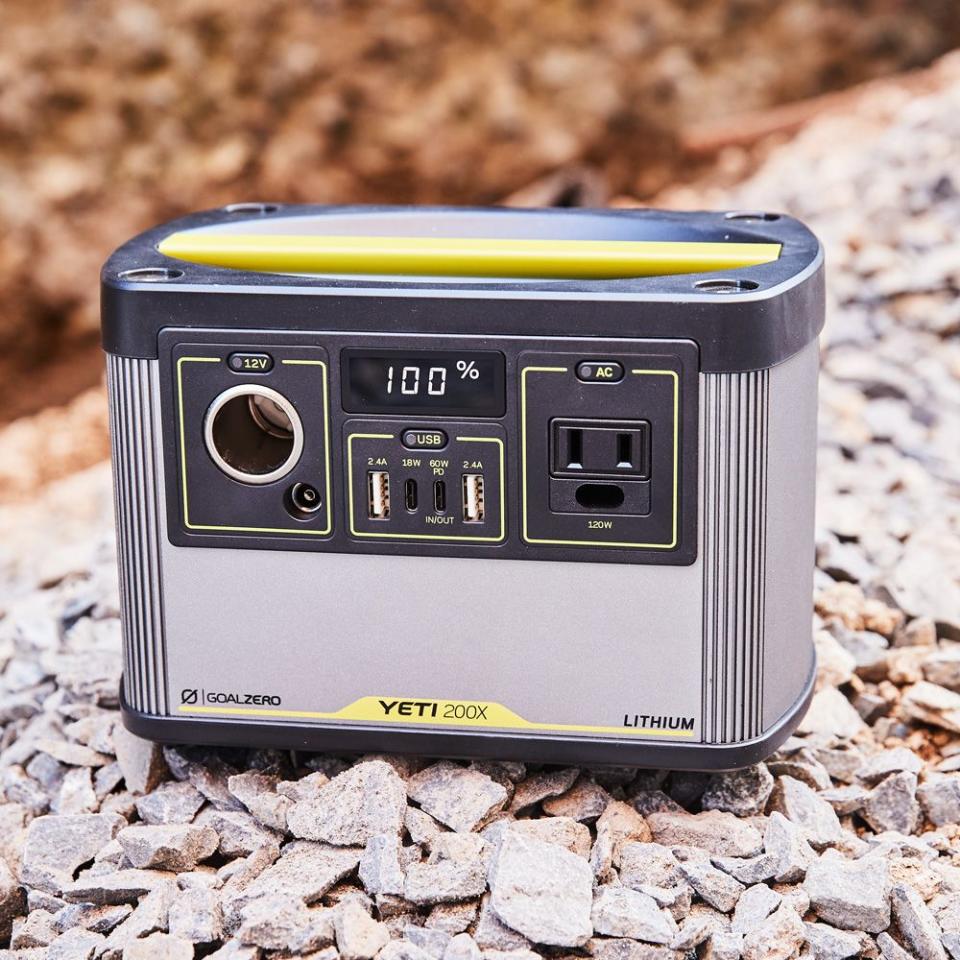
Yeti 200X Solar Generator
walmart.com
$179.00
Trevor RaabExplorer 240 Portable Power Station
Most of my needs are for charging smaller items… I don’t own a camper or RV, and I don’t need to power a refrigerator out in the wild. It’s hard to say what’s more relevant for outdoors people, but for those who have low-maintenance car camping setups like myself, this 240WH power station is probably all you need.
This is reasonably priced, weighs just over 6.5 pounds, and is reliable for its cost. I’d recommend this for people heading out for an overnight or weekend but want to keep lower-powered devices charged. It’s also a great backup to leave stashed in a vehicle for emergencies, as it doesn’t take up too much space. I was surprised that you need to push the buttons to activate the charging (I had assumed I could just plug something into the port and it would start charging), but double-check that your gear (or the unit) is actually charging.
The handle is comfortable to carry, and since this is such a small power bank, the top handle is sufficient for moving it around. I’ve been able to fully charge this with the Jackery SolarSaga 60W solar panel in just under 5 hours, which is pretty rad for a power bank that can charge an iPhone 24 times.
The Explorer 240 can charge five devices at once, with a USB-C port, two USB-A ports, and a 100-watt AC outlet. It’s one of the most portable on this list, and is also super convenient for fast charging for an overnight trip.
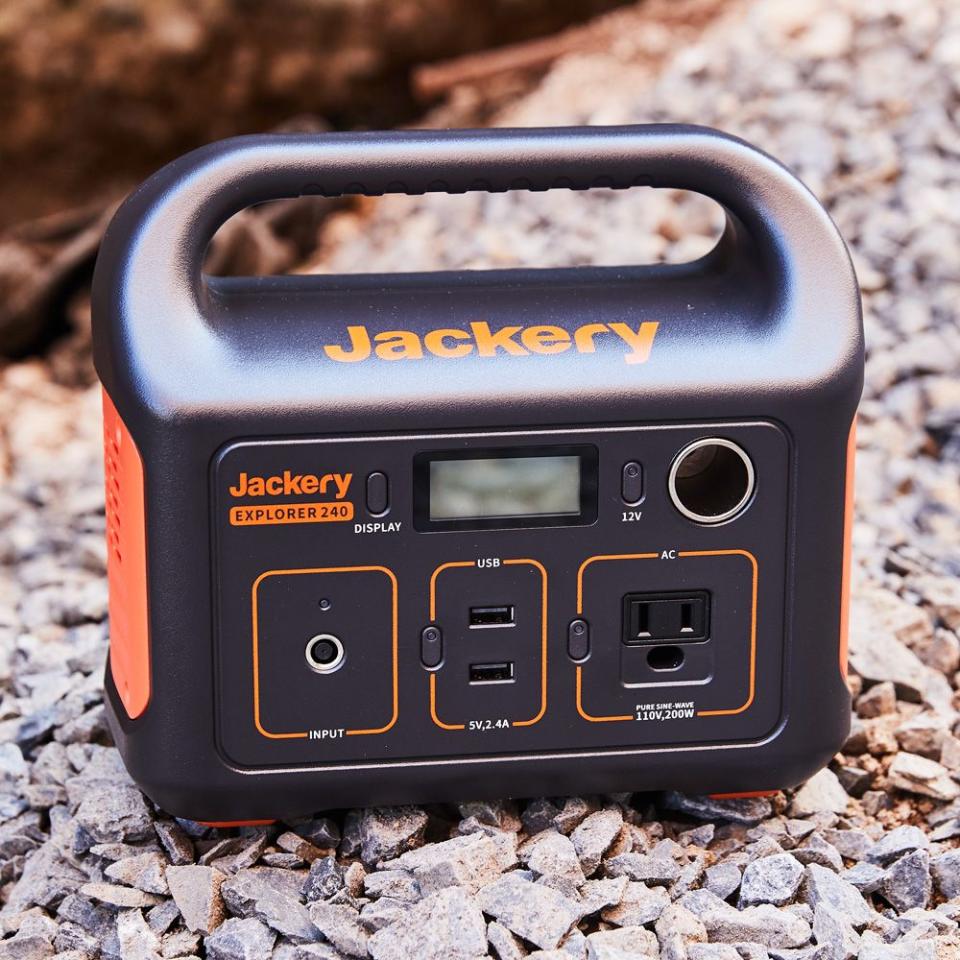
Explorer 240 Portable Power Station
amazon.com
$219.00
Trevor RaabYeti 1500X Solar Generator
Optimized for campers who spend extended periods of time off-grid, this high-powered generator has a 600-watt input, allowing it to fully charge in just a few hours with the right equipment. This model will run a full camper or serve as a reliable backup for home power, and the simple interface and charging adapters add to its appeal.
I love the adaptability of this unit, which comes with additional add-ons like the Home Integration Kit, which allows people to hook it up to an in-house circuit breaker. It also has something the brand calls the “Expansion Module,” which gives it the ability to charge it via your vehicle’s alternator on the road. This is a solid all-around pick for anyone who doesn’t want to be caught off-guard with power needs and wants a few ways to make sure the power bank stays charged.
This is one of the best-selling power stations on the market, with enough juice to run a full-size fridge for more than 28 hours and charge a smartphone 127 times. It has over 1,500 watt-hours of capacity, making it a stellar option for running a camper. It can be recharged in anywhere from six to 14 hours in a wall charger, depending on what gear you have.
This model comes with a few different options for solar panels—just be sure to read the specs and charging time before deciding which one to get. The Goal Zero’s 100-watt solar panel takes roughly 18 to 36 hours to recharge the power station, depending on conditions.
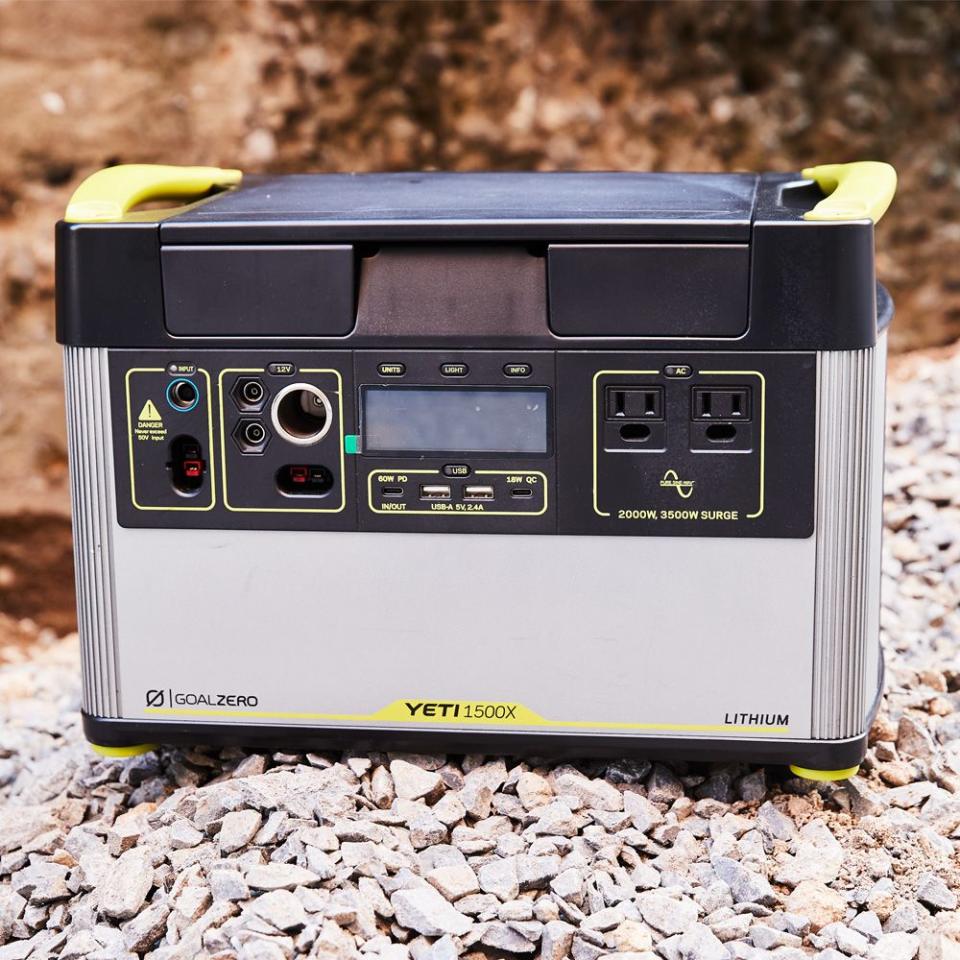
Yeti 1500X Solar Generator
amazon.com
$1499.95
Trevor RaabSOLIX F2000 Generator
The heavy-duty wheels and telescoping handle on Anker’s SOLIX F2000 are easy to use, allow you to stand upright when pulling, and are a dream for people who regularly find themselves moving their power station around, whether it’s at a campsite or to different parts of the house during a power outage.
Along with convenience, this generator is a powerhouse, and can easily keep your refrigerator running, a heater for greenhouses (yes, we received questions about this) and your RV bright and warm.
We’re also impressed with Anker’s app that allows us to check the charging status or power being generated without continually going outside to check. The app also lets you turn power to the AC and USB ports on and off remotely, keeping tabs on how much energy is being utilized.
The SOLIX F2000 has 12 ports, including two car ports, an RV-specific outlet, four AC ports, three USB-C charging ports, and two for USB-A. In sunny conditions and moderate temperatures, this can recharge with a 200-watt solar panel in just a few hours, and can support up to 1,000 watts of solar input.

SOLIX F2000 Generator
amazon.com
$1399.00
Delta Portable Power Station
Falling right in the sweet spot of weight, this power bank is lighter for its power than the Yeti 1500X, and it stays secure when strapped down in a moving vehicle or camper. The EcoFlow Delta has the most ports (13!) out of any power station on this list, which means more charging efficiency and easier tracking of charge drain, perfect if you need to power and charge several devices in a short amount of time.
This is a beefy generator. With 1,800 watts of total output and over 1,200 watt hours, this is powerful enough to charge anything you would bring overlanding or camping. It could even power up an electric vehicle if you get stuck with no charging station in sight.
Despite the larger capacity, this model can be charged with four 100-watt solar panels in just four hours with optimum conditions, and eight hours in most conditions—which I find impressively fast for a power station of this size. It charges fast in a standard wall AC outlet as well, going from zero to 80-percent in just an hour. This is on the heavier side, but with that much power and so many charging options, it can be worth it for a one-and-done power setup.
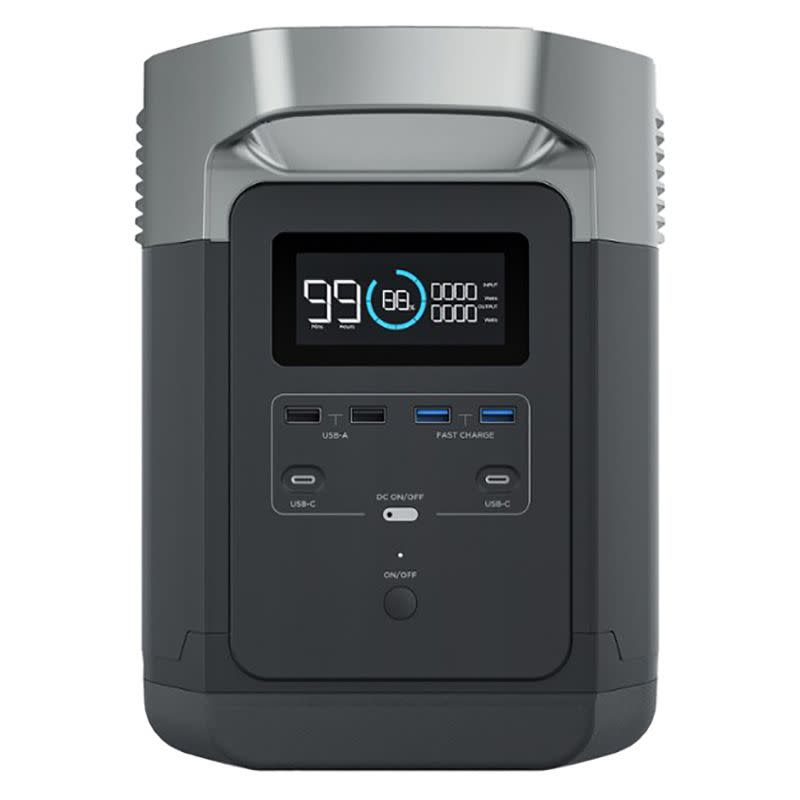
Delta Portable Power Station
lowes.com
$999.00
Yeti 500
The sixth iteration of Goal Zero’s Goldilocks-sized power station, the Yeti 500 has a similar capacity and capabilities as the previous model, the Yeti 500 X. This is a fantastic middle ground for anyone looking for an off-grid weekend, or who might not need to power appliances during an extended outage, but who wants peace of mind in case of emergencies.
The 500W AC power doubles to 1000W with the surge mode, and has enough power to run a refrigerator, lights in a camper, and small kitchen appliances, so even with a power outage, you can still have your morning coffee and keep your perishable items safe.
Goal Zero’s entire line is quite rugged, built for outside and travel use without the stress of fragile items. The Yeti 500 is highly water resistant with a rating of IPX4, and is shock proof and can maintain power output (though less efficiently) at below-zero temperatures.
This also has a faster charging time compared to previous models, and can fully charge in less than an hour and a half in a standard AC outlet, though solar panel charging will take around three hours with a 200W panel.
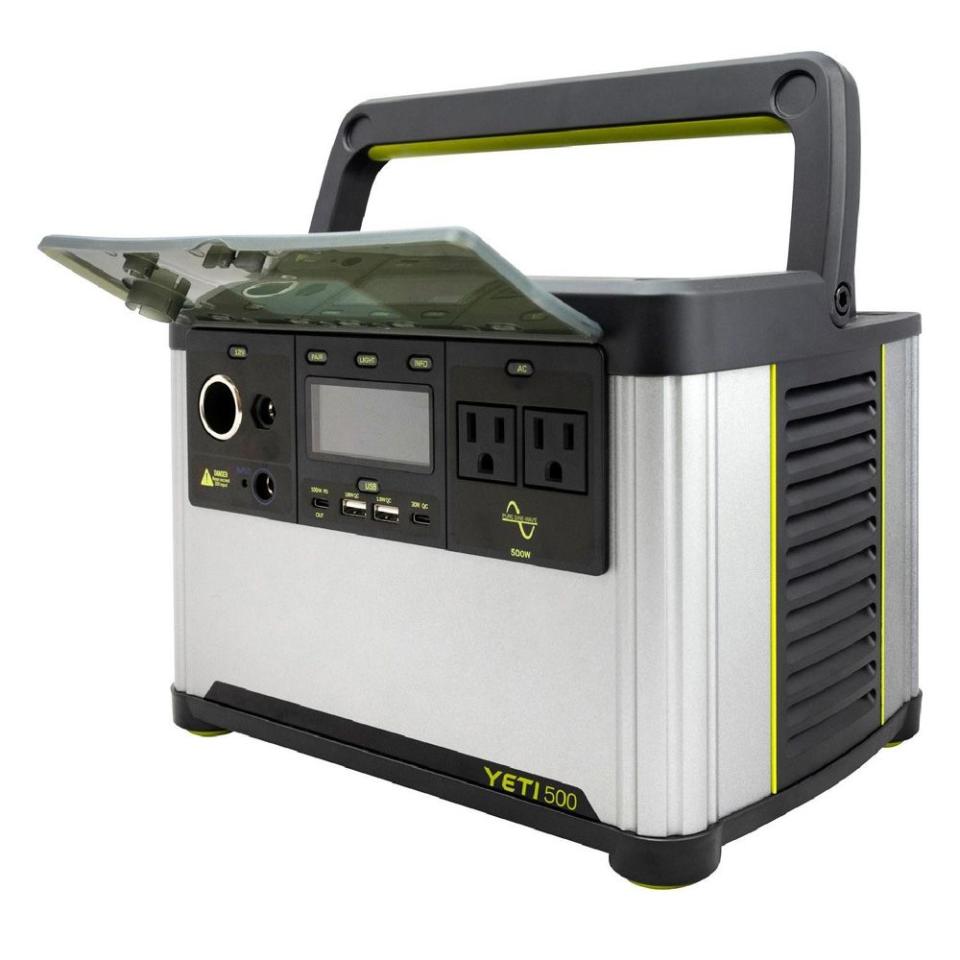
Yeti 500
rei.com
$499.95
B2000 Solid State Solar Generator
Tested and Reviewed by Brad Ford
(Note: this model is available with two or three solar panels. We only tested it with one, so I’m doubling my findings with respect to solar observations, to align with performance for two panels)
Yoshino’s B2000 Solar Generator is different from virtually any other on the market, in that it utilizes a solid state battery. This means the electrolyte in the battery is solid, rather than a liquid. There are a couple advantages of a solid electrolyte—First, it has a higher energy density, allowing the battery size/weight to be reduced. Second, solid electrolytes are more stable and won’t leak. Regarding weight, the B2000 is both light and compact for its capacity.
We tested solar charging on a cloudless, winter day in Northeast, PA. In the bright, mid-day sun, using one portable 200-watt panel, we topped out at 181 watts input. With two panels, that would translate to 362 watts and an estimated charge time between three and four hours. Over the course of five hours, we repositioned the panel twice, to keep optimal alignment with the sun as input slowly dropped to 70-watts for the one panel.
On average we were able to charge the battery at about 10% per hour, which is pretty respectable for portable panels. Adding a second panel doubles the watts, and cuts charging time in half.
The power station itself performed well when tested running a 21-cubic foot, full size refrigerator. We were able to get an impressive 18 hours and 8 minutes of run time, from 100% charge, until the B2000 shut down. And with Wi-Fi connectivity, we were able to monitor the power usage remotely with Yoshino’s app, on a smartphone.
We also tested the B2000, using a constant load of 470-watts which it ran for 2 hours and 24 minutes. For reference, we used four 60-watt light bulbs, an oscillating fan, and a small personal heater to reach 470-watts. The unit has two USB-C ports, two USB-A ports, and a wireless charging pad on top.
The B2000 features multiple charging options. Aside from solar, it can also be charged via a 120-volt AC outlet, or 12-volt DC car adapter—included.
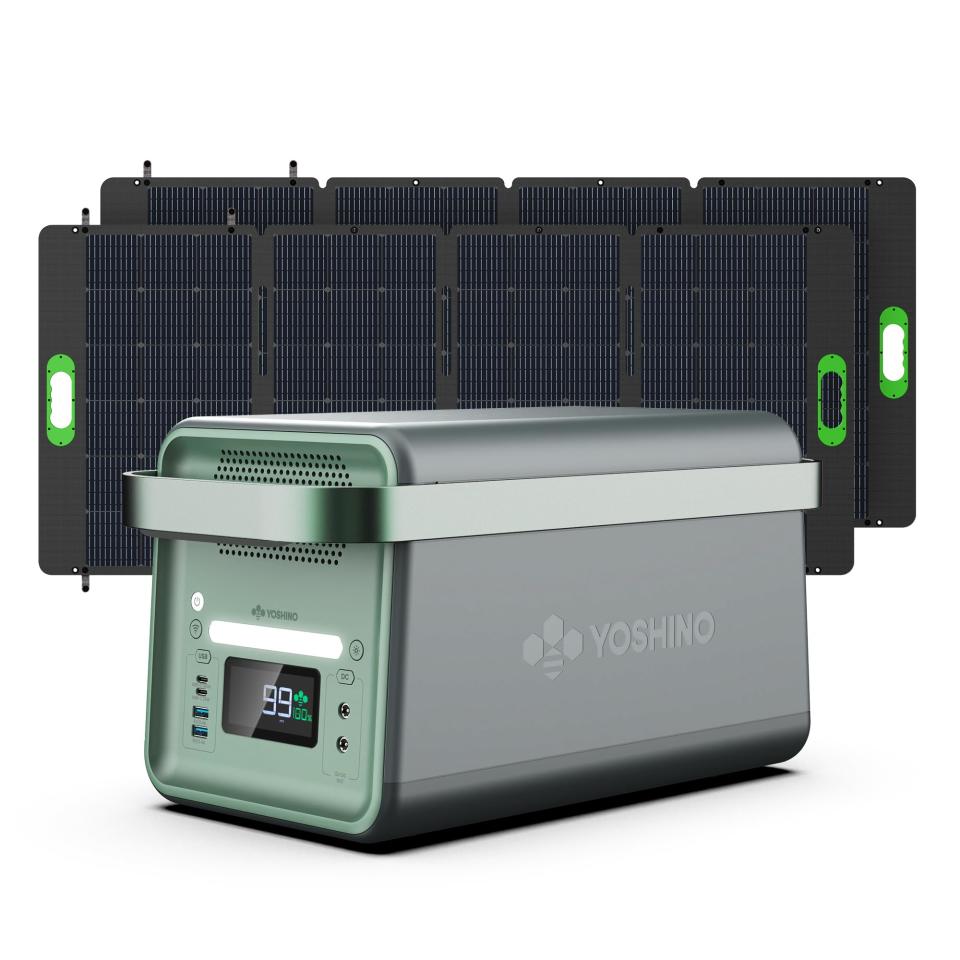
B2000 Solid State Solar Generator
amazon.com
$2549.00
Charging Tips to Keep Your Solar-Powered Generator Running From Expert Maggie Slepian
What are your priorities when choosing a solar-powered generator?
I am a low-maintenance camper, and most of my background is in lightweight backcountry travel. That means I prioritize space-saving and ease-of-use, so my go-to power banks have between 250 to 600 watt hours, and weigh less than 15 pounds.
This is perfect for a weekend trip, with the on-the-go (car or solar) charging capabilities to put my mind at ease for longer trips. Mostly I’m charging small items, so one charge lasts a long time. However, plenty of people in the van-life and remote-work world are powering their RVs and vans, and relying on multiple laptop charges. For that, I’d recommend one of the larger units.
What can a solar-powered generator charge and power?
A solar-powered generator can charge and run almost anything that requires power—it just depends on the capacity. These generators can charge power tools in the shop, laptops for remote work, and personal devices like bluetooth headphones and speakers.
A solar-powered generator with a higher power capacity can even power household appliances in the event of a power outage. And the fact that these are solar-compatible means you aren’t reliant on the electrical grid to recharge them.
What is the best way to charge a generator?
Every unit on our list has multiple charging options, including wall (AC outlet), car (12-volt), and solar. Each input method charges your unit at a different speed, and solar also depends on the conditions.
I try to charge up my power banks whenever I can, so I’m never caught off guard trying to leave on a trip with a dying power bank. If this happens (which it has), I’ll charge it in my vehicle's 12-volt port while I’m driving, though this is often slower than solar or a wall unit.
Solar power is the most sustainable and typically fastest way to power these— just be sure you have enough wattage in the solar panels to make it effective. I recommend keeping the generator stored with at least an 80 percent charge, and unplug them once they’re fully charged—keeping them plugged in longer than necessary can degrade the battery.
Most units will have a simple readout display showing the remaining battery charge, and it’s a good practice not to allow your battery pack to get below 20 percent.
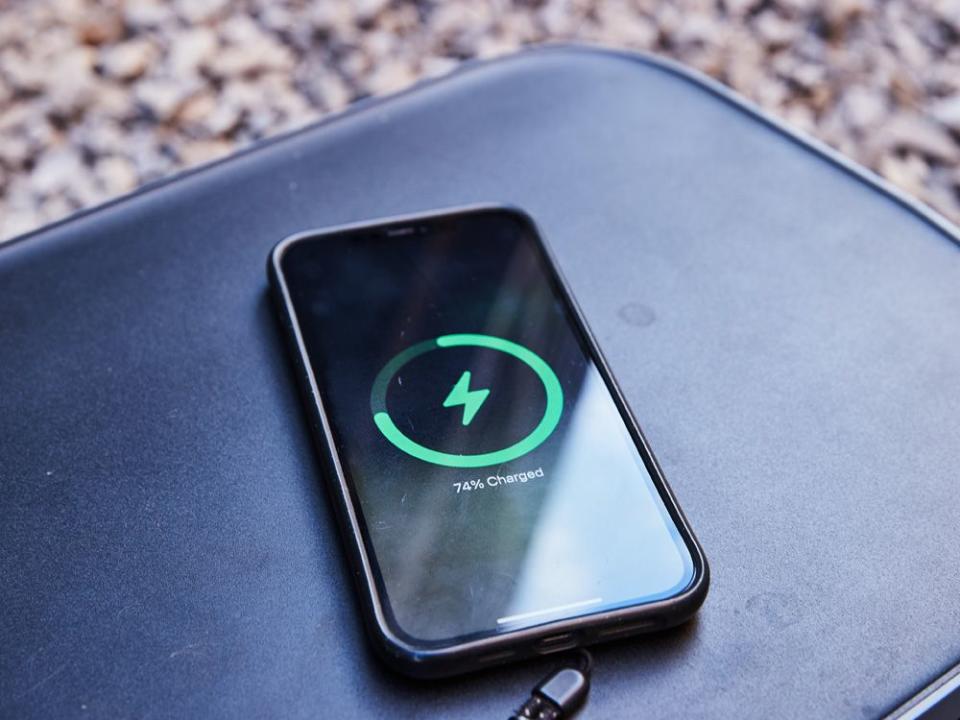
You Might Also Like

